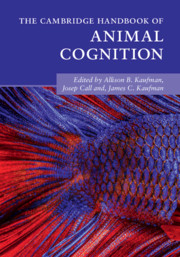Book contents
- The Cambridge Handbook of Animal Cognition
- The Cambridge Handbook of Animal Cognition
- Copyright page
- Dedication
- Contents
- Figures, Tables, and Boxes
- Contributors
- Acknowledgments
- Introduction
- Part I Communication and Language
- Part II Memory and Recall
- 6 Memory and Recall Overview
- 7 A Fish Memory Tale
- 8 Memory in Hummingbirds
- 9 Event Memory in Rats
- 10 Primate Recall Memory
- Part III Social Cognition
- Part IV Social Learning and Teaching
- Part V Numerical and Quantitative Abilities
- Part VI Innovation and Problem-Solving
- Index
- References
9 - Event Memory in Rats
from Part II - Memory and Recall
Published online by Cambridge University Press: 01 July 2021
- The Cambridge Handbook of Animal Cognition
- The Cambridge Handbook of Animal Cognition
- Copyright page
- Dedication
- Contents
- Figures, Tables, and Boxes
- Contributors
- Acknowledgments
- Introduction
- Part I Communication and Language
- Part II Memory and Recall
- 6 Memory and Recall Overview
- 7 A Fish Memory Tale
- 8 Memory in Hummingbirds
- 9 Event Memory in Rats
- 10 Primate Recall Memory
- Part III Social Cognition
- Part IV Social Learning and Teaching
- Part V Numerical and Quantitative Abilities
- Part VI Innovation and Problem-Solving
- Index
- References
Summary
People remember specific earlier events that happened to them by using episodic memory. Accordingly, researchers have sought to evaluate the hypothesis that nonhumans retrieve episodic memories. The central hypothesis of an animal model of episodic memory proposes that, at the moment of memory assessment, the animal retrieves a memory of the specific earlier event. Testing this hypothesis requires the elimination of the hypothesis that animals solve such problems by using non-episodic memory. Most of the research on event memory in nonhumans focuses on memory of a single event. Here, I describe approaches that we have used with rats to move from episodic memory of one event to two events, to many events, and to sequentially ordered events. These studies focus on source memory, binding of episodic memories, remembering items-in-context, and the replay of episodic memories. Connections between episodic memory and hippocampal replay are explored. These approaches may be used to explore the evolution of cognition.
Keywords
- Type
- Chapter
- Information
- The Cambridge Handbook of Animal Cognition , pp. 190 - 209Publisher: Cambridge University PressPrint publication year: 2021
References
- 3
- Cited by



